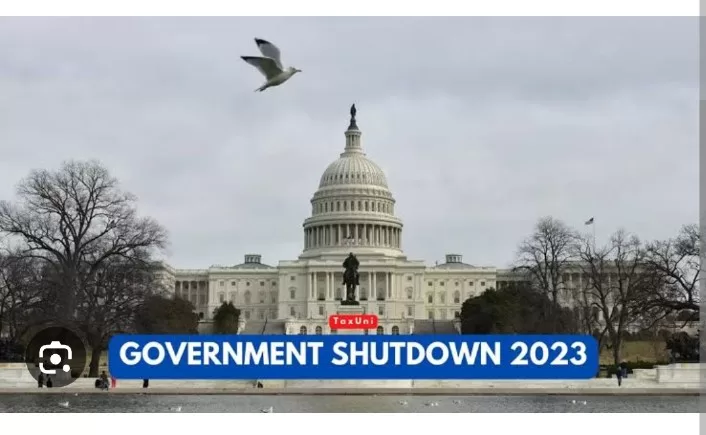Washington, D.C.: The United States teeters on the precipice of a complete government shutdown, driven by an impasse in Congress where rightwing Republican lawmakers, motivated by a commitment to deep public spending cuts, have plunged the nation into a political quagmire.
Background: Funding for federal agencies is set to expire at midnight on September 30th, an imminent crisis exacerbated by the ideological chasm within the Republican majority in the House of Representatives. The outcome hinges on Congress’s ability to pass 12 appropriations bills to finance government operations, crucial to commencing the new financial year on October 1st. The stakes are high, with potential repercussions ranging from disruptions to public services and salary delays to severe damage to the national economy if the shutdown persists.
Content: The central point of contention lies in the uncertain status of Republican House Speaker, Kevin McCarthy, who has come under fire from fellow party members. McCarthy’s alleged transgression involves his concurrence with President Joe Biden on spending limits, a decision vociferously criticized by the GOP’s far-right “Freedom Caucus” for being too generous, leading to calls for immediate fiscal pruning.
Implications of a US Government Shutdown
– Furloughs: Thousands of federal government employees face furloughs, being instructed not to report for work and forgoing payment during the shutdown period. Their salaries are retroactively compensated upon resolution.
– Essential Services: Certain government workers providing vital services like air traffic control and law enforcement continue working but do not receive compensation until Congress resolves the shutdown.
– National Parks: Depending on the duration, national parks may close entirely or operate with reduced services, affecting public amenities such as toilets and attendants. Passport processing and research at national health institutes may halt.
– Public Safety and Health: Federal inspections ensuring food safety and preventing hazardous substances from contaminating drinking water may cease for the duration.
– Child Programs: Approximately 10,000 children aged three and four may lose access to Head Start, a federally funded program that fosters school readiness among young children, particularly those from low-income families.
Causes of a Shutdown: The legal framework for a government shutdown arises from the Anti-Deficiency Act, enacted in 1884. This legislation prohibits federal agencies from spending or obligating funds without congressional appropriation or alternative approval. Failure by Congress to pass the required 12 annual appropriations bills forces non-essential government functions to cease, resulting in a partial government shutdown.
Frequency of Shutdowns: Historically, government shutdowns were virtually non-existent for the first two centuries of US history. However, they have become increasingly recurrent in recent decades as a byproduct of escalating political polarization and the regular use of brinkmanship in Washington. Since 1976, when the US fiscal year commenced on October 1st, there have been 20 federal funding gaps. Three stand out as pivotal moments in American politics:
– A 21-day partial shutdown in 1995, a dispute between President Bill Clinton and Republican Speaker Newt Gingrich over spending cuts that set a precedent for future partisan congressional clashes.
– In 2013, a 16-day partial shutdown occurred as a Republican-led Congress sought to defund Barack Obama’s Affordable Care Act, popularly known as Obamacare.
– The longest recorded shutdown, lasting 34 days from December 2018 to January 2019, took place as President Donald Trump demanded $5.7 billion in funding for a border wall along the US-Mexico border, impacting his approval ratings.
Triggers for the Current Impasse: The ongoing crisis primarily stems from House Speaker Kevin McCarthy’s precarious position within the Republican-controlled House. With a slender majority in the 435-seat chamber, McCarthy’s ascent to his current role required a record 15 ballots in January. His position was secured only after intense negotiations with a faction of far-right Republicans. Now, these same conservatives are wielding their influence by withholding support for appropriations bills that they deem too generous based on prior agreements with President Biden. McCarthy could potentially pass the bills with bipartisan support, but far-right elements, notably Congressman Matt Gaetz of Florida, have pledged to dethrone him if he pursues such a course.
Potential Resolutions: There is a glimmer of hope through the possibility of deploying a stopgap spending measure known as a “continuing resolution” (CR). This measure could temporarily fund the government until October 31st, allowing further negotiations for the final spending bills for 2024. However, even this compromise has failed to gain the approval of the Freedom Caucus, who demand that it incorporates more radical conservative policies such as addressing “woke policies” and the “weaponization of the Department of Justice.” Proposed amendments from the rightwing Georgia congresswoman Marjorie Taylor Greene include resolutions to prevent funding for Ukraine and bans on funding for Covid-19 vaccine mandates.
Economic Consequences: The Congressional Budget Office estimated that the 2018-19 shutdown imposed a short-term cost of $11 billion on the US economy, with approximately $3 billion never recovered post-shutdown. Presently, economists warn that the impact could be exacerbated by unrelated factors like persistent inflationary pressures and the United Auto Workers strike against major car manufacturers, which could expand if demands remain unmet.
President Biden’s Response: President Biden has utilized his platform to emphasize the accountability of GOP holdouts, underlining that they would bear responsibility if a shutdown occurs. He cautioned about the consequences for US military personnel, who would continue working without pay. The White House has also published contingency plans outlining how government agencies should operate in the event of a shutdown and fund depletion.







